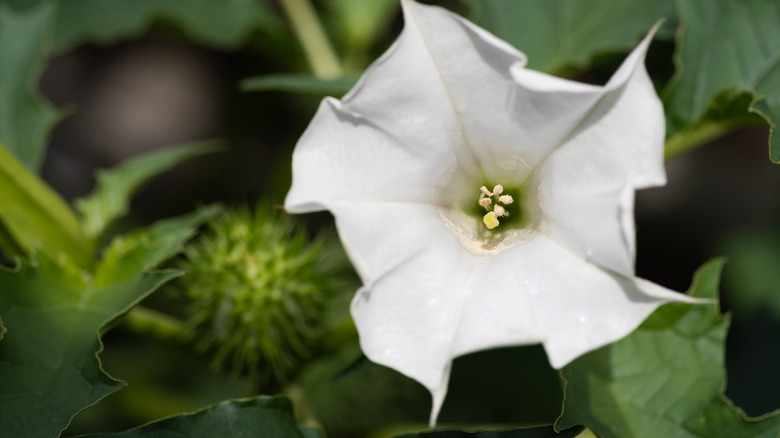Essential Tips To Get Rid Of Jimsonweed (& Why You Should)
Chancing upon funnel-shaped, lavender-disked, white flowers during your midnight stroll as they unfold and embrace sphinx moths in their folds may instantly make you thankful to Mother Nature for turning your yard into a moon garden. But make no mistake, these unasked-for, albeit gorgeous, blooms are no moon flowers. Rather, they crown the head of jimsonweed (Datura stramonium), an invasive species (in West Virginia, Connecticut, Pennsylvania, and Michigan) that literally blows the devil's trumpet, or so implies its alternative name. As they're fatally toxic when consumed and tend to persist once tap-rooted, jimsonweeds deserve no space in your yard and should be banished — the sooner, the better. Physical removal, cultivation, and flaming are the main ways to get rid of jimsonweed, with chemical treatments coming in for the clinch as a last resort.
Prevalent across the U.S., barring a few colder northern and western parts, jimsonweeds tend to plop themselves in disturbed areas, such as pastures and roadside ditches. Sadly, their devil's snares are now clawing through our gardens, barnyards, and compost piles, too. Keeping in the spirit of how most weeds growing in your yard have something to say about your soil, jimsonweeds' presence is indicative of high fertility or excessive nitrogen and phosphorus concentration, especially if they grow to their full height (about 5 feet). However, they'll adapt to other soils as long as there is space to inhabit without growing as tall.
Scrubbing off jimsonweed's presence from your yard
What makes jimsonweeds such a nuisance is their fertility. In sunny, rich soils with little plant competition, they produce over 30,000 seeds in their lifetime until frost-killed or chewed off by three-lined potato beetles. Worse, most seeds remain viable for decades, even if their pods were sheared off the plant prematurely. That's why getting a lid on their growth before they produce seeds is amply important — it empowers the use of non-chemical methods and shortens the eradication journey.
Start inspecting your garden for jimsonweed seedlings around the end of spring (May through June) when they're actively surfacing. They'll usually give themselves away with their strong stench that emanates from their lance-shaped foliage any time it's crushed. After positively IDing the weed, pull out the seedlings by hand or hoe, but ensure no part of the branched taproot remains in the soil, lest it'll resprout.
Another option is to rake the soil horizontally with a tine weeder to bury the emerging weeds. You may also burn the young weeds with a propane torch, but remember to wear a mask and gloves, or the fumes may pose problems. Mowing your lawn more frequently will whittle the weed's reserves and stem seed production. Shading out the weeds through mulch will further impede their growth. If the problem persists or the invasive is past its flowering (around fall), consider bombing it with post-emergent broadleaf herbicides like Roundup or 2,4-D, followed by pre-emergent next year.
Why getting rid of jimsonweed is important
While you might be tempted to retain and admire jimsonweed as you would wild violets or dandelions, its dour toxicity is reason enough to drop that idea. Even more so if you've got kids and pets in their eat-what-they-find phase. From seeds and fruits to foliage, all plant parts of jimsonweed are highly poisonous, regardless of whether they're actively growing or drying out after being macheted. In fact, with the climate crisis intensifying, their toxicity is expected to soar higher. Jimsonweeds contain toxic alkaloids like atropine, scopolamine, and hyoscyamine that impair the nervous system. A single episode of mistaken (or deliberate) ingestion can cause symptoms like blurry vision, hot flashes, seizures, hallucinations, and occasionally, death — driving home the point that jimsonweed's beauty isn't worth this risk.
Fortunately, a mere brush against its foliage is unlikely to induce your body into breaking out in rashes. That being said, another reason for not wanting jimsonweed in your garden beds, particularly your vegetable patch, is because of its genetics. Belonging to the nightshade family, it's a cousin to potatoes, tomatoes, and peppers, and these striking weeds play host to the same pests and diseases, adversely affecting your crop.


